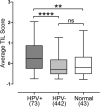Low expression of NSD1, NSD2, and NSD3 define a subset of human papillomavirus-positive oral squamous carcinomas with unfavorable prognosis
- PMID: 33588906
- PMCID: PMC7885607
- DOI: 10.1186/s13027-021-00347-6
Low expression of NSD1, NSD2, and NSD3 define a subset of human papillomavirus-positive oral squamous carcinomas with unfavorable prognosis
Abstract
Background: Frequent mutations in the nuclear receptor binding SET domain protein 1 (NSD1) gene have been observed in head and neck squamous cell carcinomas (HNSCC). NSD1 encodes a histone 3 lysine-36 methyltransferase. NSD1 mutations are correlated with improved clinical outcomes and increased sensitivity to platinum-based chemotherapy agents in human papillomavirus-negative (HPV-) tumors, despite weak T-cell infiltration. However, the role of NSD1 and related family members NSD2 and NSD3 in human papillomavirus-positive (HPV+) HNSCC is unclear.
Methods: Using data from over 500 HNSCC patients from The Cancer Genome Atlas (TCGA), we compared the relative level of mRNA expression of NSD1, NSD2, and NSD3 in HPV+ and HPV- HNSCC. Correlation analyses were performed between T-cell infiltration and the relative level of expression of NSD1, NSD2, and NSD3 mRNA in HPV+ and HPV- HNSCC. In addition, overall survival outcomes were compared for both the HPV+ and HPV- subsets of patients based on stratification by NSD1, NSD2, and NSD3 expression levels.
Results: Expression levels of NSD1, NSD2 or NSD3 were not correlated with altered lymphocyte infiltration in HPV+ HNSCC. More importantly, low expression of NSD1, NSD2, or NSD3 correlated with significantly reduced overall patient survival in HPV+, but not HPV- HNSCC.
Conclusion: These results starkly illustrate the contrast in molecular features between HPV+ and HPV- HNSCC tumors and suggest that NSD1, NSD2, and NSD3 expression levels should be further investigated as novel clinical metrics for improved prognostication and patient stratification in HPV+ HNSCC.
Keywords: Epigenetics; HPV; Head and neck cancer; Head and neck squamous cell carcinoma; Histone methyltransferase; The Cancer Genome Atlas; WHSC1; WHSC1L1.
Conflict of interest statement
The author reports no conflicts of interest in this work.
Figures





Similar articles
-
Understanding the Roles of the NSD Protein Methyltransferases in Head and Neck Squamous Cell Carcinoma.Genes (Basel). 2022 Nov 2;13(11):2013. doi: 10.3390/genes13112013. Genes (Basel). 2022. PMID: 36360250 Free PMC article. Review.
-
NSD1 mutations by HPV status in head and neck cancer: differences in survival and response to DNA-damaging agents.Cancers Head Neck. 2019 Jul 8;4:3. doi: 10.1186/s41199-019-0042-3. eCollection 2019. Cancers Head Neck. 2019. PMID: 31321084 Free PMC article.
-
Evaluation of NSD2 and NSD3 in overgrowth syndromes.Eur J Hum Genet. 2005 Feb;13(2):150-3. doi: 10.1038/sj.ejhg.5201298. Eur J Hum Genet. 2005. PMID: 15483650
-
Cancers and the NSD family of histone lysine methyltransferases.Biochim Biophys Acta. 2011 Dec;1816(2):158-63. doi: 10.1016/j.bbcan.2011.05.004. Epub 2011 Jun 6. Biochim Biophys Acta. 2011. PMID: 21664949 Review.
-
NSD3, a member of nuclear receptor-binding SET domain family, is a potential prognostic biomarker for pancreatic cancer.Cancer Med. 2023 May;12(9):10961-10978. doi: 10.1002/cam4.5774. Epub 2023 Apr 16. Cancer Med. 2023. PMID: 37062069 Free PMC article.
Cited by
-
Understanding the Roles of the NSD Protein Methyltransferases in Head and Neck Squamous Cell Carcinoma.Genes (Basel). 2022 Nov 2;13(11):2013. doi: 10.3390/genes13112013. Genes (Basel). 2022. PMID: 36360250 Free PMC article. Review.
-
High Risk-Human Papillomavirus in HNSCC: Present and Future Challenges for Epigenetic Therapies.Int J Mol Sci. 2022 Mar 23;23(7):3483. doi: 10.3390/ijms23073483. Int J Mol Sci. 2022. PMID: 35408843 Free PMC article. Review.
-
miR-154 Influences HNSCC Development and Progression through Regulation of the Epithelial-to-Mesenchymal Transition Process and Could Be Used as a Potential Biomarker.Biomedicines. 2021 Dec 13;9(12):1894. doi: 10.3390/biomedicines9121894. Biomedicines. 2021. PMID: 34944712 Free PMC article.
-
Lysine Methyltransferase NSD1 and Cancers: Any Role in Melanoma?Cancers (Basel). 2022 Oct 5;14(19):4865. doi: 10.3390/cancers14194865. Cancers (Basel). 2022. PMID: 36230787 Free PMC article. Review.
-
Structural and functional specificity of H3K36 methylation.Epigenetics Chromatin. 2022 May 18;15(1):17. doi: 10.1186/s13072-022-00446-7. Epigenetics Chromatin. 2022. PMID: 35581654 Free PMC article. Review.
References
-
- Bray F, Ferlay J, Soerjomataram I, Siegel RL, Torre LA, Jemal A. Global cancer statistics 2018: GLOBOCAN estimates of incidence and mortality worldwide for 36 cancers in 185 countries. CA Cancer J Clin. 2018;68:394–424. - PubMed
-
- Hashibe M, Brennan P, Chuang S-C, et al. Interaction between tobacco and alcohol use and the risk of head and neck cancer: pooled analysis in the international head and neck Cancer epidemiology consortium. Cancer Epidemiol Biomark Prev. 2009;18:541–550. doi: 10.1158/1055-9965.EPI-08-0347. - DOI - PMC - PubMed
Grants and funding
LinkOut - more resources
Full Text Sources
Other Literature Sources
Research Materials

